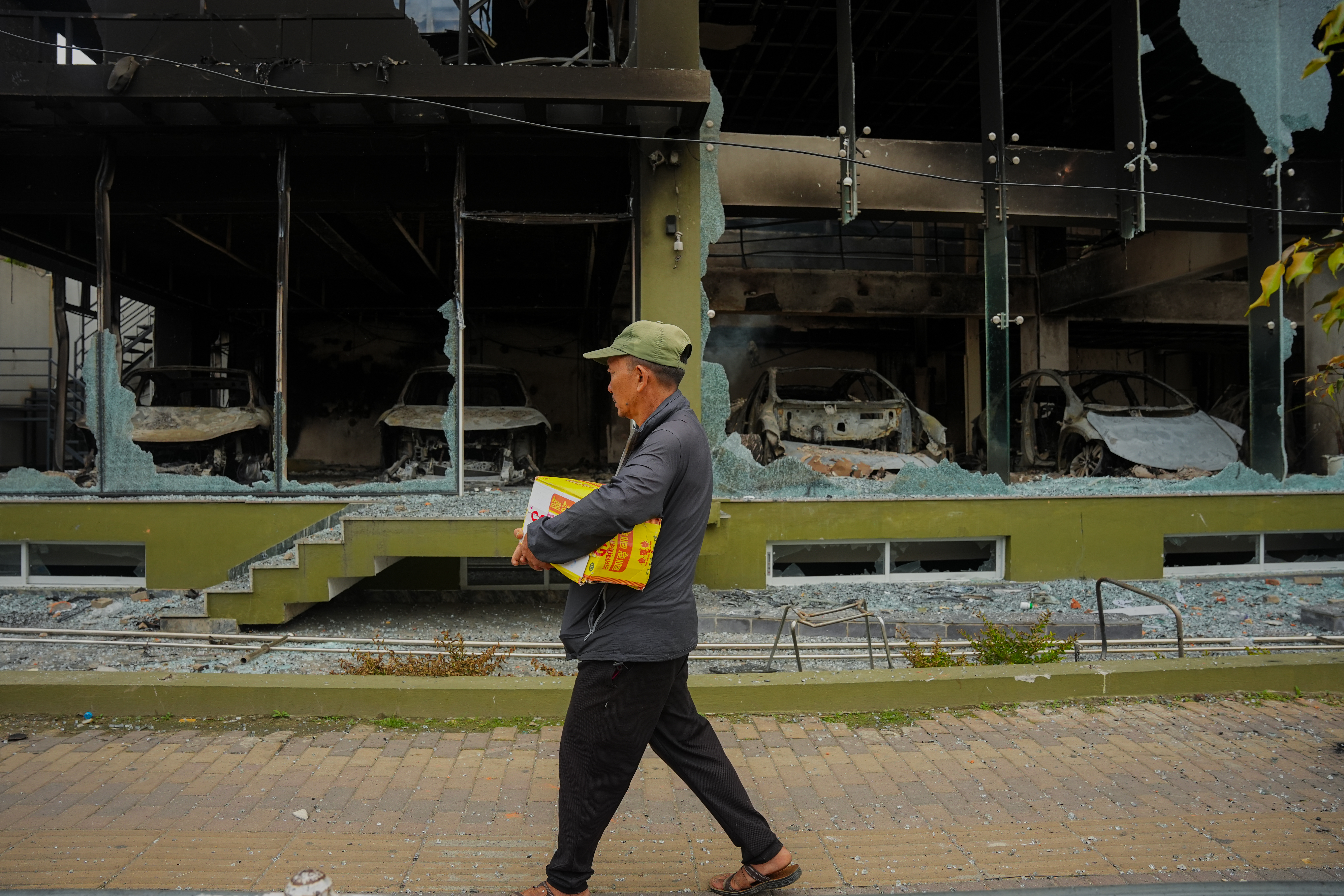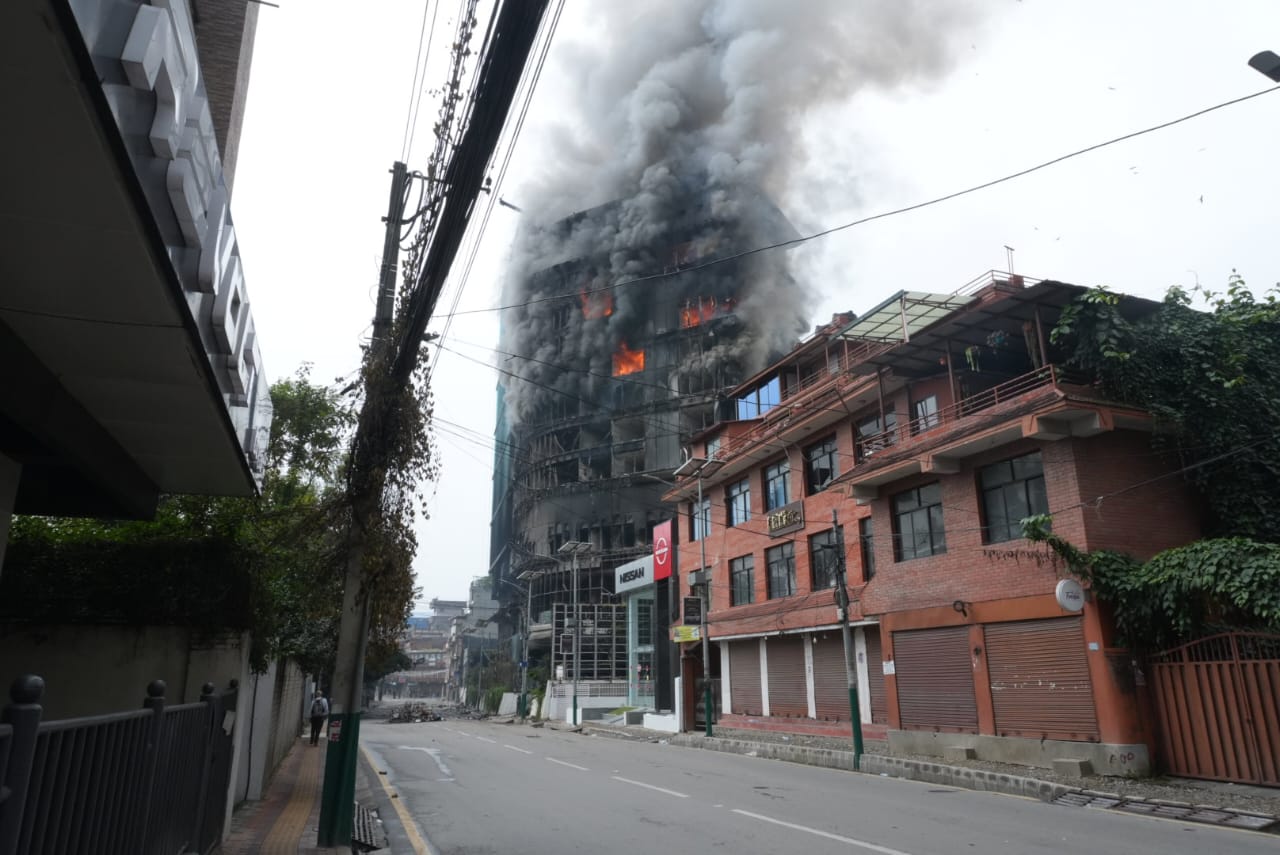Relocate, reallocate, recover
Nepal starts picking up the pieces after last week’s destruction to build back a stronger economyNepal’s public and private sector are clearing the ash and rubble from destroyed institutions to take stock after last week’s nationwide protests that cost at least 72 lives and caused widespread destruction.
The most visible destruction was of buildings housing the legislature, executive, and judiciary and hundreds of other government agencies. At least 1,000 vehicles were torched, offices looted.
Many of these offices first have to relocate. The Prime Minister’s Office, which was gutted, and interim Prime Minister Sushila Karki have moved into the new Home Ministry Building. Similarly, the completion of the new Parliament Building may have to be expedited for just after elections next year.
The Supreme Court is working out of tents before relocating to its new building which is under construction. Arson attacks have also destroyed many hardcopy court records and case files, and these will be impossible to repair.
The private sector is also reeling— the Hotel Association of Nepal (HAN) says two dozen hotels mainly in Kathmandu and Pokhara sustained losses worth Rs25 billion in last week’s arson and vandalism. The Hilton Hotel was completely gutted and is said to have suffered Rs8 billion in damages, while the Hyatt, Varnabas and others were damaged. The jobs of 2,000 hospitality workers have been directly affected.
Of the 28 Bhatbhateni outlets across Nepal, 21 were attacked — at least 12 were completely destroyed by fire while nine were vandalised and looted. At least 5,000 jobs are directly at risk, while tens of thousands of vendors across the country have been affected.
‘Amid rising unemployment and capital flight, Bhat-Bhateni has been providing employment to 22,000 youths, not only employment generation, it also significantly continues to contribute to the local economy,’ the Tamu (Gurung) Educational and Career Advancement Network (TECANET) wrote in a statement this week, urging immediate investigation into the destruction of Bhatbhateni and other public and private institutions.
Chaudhary Group and Ncell were also among prominent corporate entities targeted by agitators, as were automobile showrooms in various cities.
“The protests last week were a reflection of the loss of trust of citizens towards the Nepali nation-state,” explains economist Pushkar Bajracharya, formerly of the National Planning Commission. “The destruction of institutions and infrastructure has set Nepal back at least 10 years.”

Nepal’s newly-appointed Finance Minister Rameshore Khanal said after his swearing in on Monday that his first order of business was to make an inventory of the scale of destruction. Economists have estimated losses amounting to trillions, and experts have said the damage is greater than the 2015 earthquake.
The majority of Nepal’s public institutions, including the Singha Durbar and the Supreme Court, parts of which were burnt to the ground, were not insured despite Nepal's history of conflict and natural disasters.
“The events of last week should be a lesson about the need for our public sector to be insured,” says economist Kalpana Khanal of the Policy Research Institute (PRI). “We have to now decentralise risk and institutionalise risk diversification not just for the recovery and reconstruction, but for all future infrastructure projects.”
The private sector is also taking stock of damage to begin the process of insurance claims, and Nepal’s insurance sector needs to calculate how much insurance and reinsurance can sustain rebuilding efforts. The damage will also reverberate across real estate sector, and has already affected the stock market.
The Nepal Stock Exchange (NEPSE) is set to resume on Thursday after the share market plummeted 47.52 points last week before trading was suspended. Experts predict further market uncertainty as a more accurate account of the loss and damage is calculated. Insurance claims will then go up, leading to a further slide in share value of these companies.
Nepal’s budget will also have to be redistributed to address the most immediate reconstruction needs. Finance Minister Rameshore Khanal will now have to implement what he has long recommended: to allocate budgetary items by priority rather than number of projects.
“In order for our rebuilding efforts to be effective, we need to ensure that the budgetary process is redirected in a way that does not fragment the budget towards many projects as has been happening so far, but prioritises important projects,” says Khanal, who has said the emphasis will be in job creation.
After being sworn in, the Minister vowed to do away with fragmented projects, directing Ministry officials to reprioritise spending and has formed a three-member task force to identify low-priority projects to redirect spending towards the reconstruction of public institutions.
“Economic reallocation, rehabilitation, and recovery through the correct mobilisation of domestic revenue, international resources and the private sector is the way through this crisis,” says Bajracharya.
Protestors last week zeroed in on Land Revenue offices, Departments of Survey, and tax offices and this will affect revenue collection across the country. Additionally, Nepal will also have to rebuild many of its institutions from the ground up during a time of decreasing bilateral aid.
DEBT BURDEN
Nepal is set to achieve LDC graduation in 2026, which means that multilateral aid, grants and loans for reconstruction might not be forthcoming. The additional loans and grants will carry higher interest rates, adding to Nepal’s significant debt burden.
While some experts do not see the GenZ revolt having a significant impact on Nepal’s status, others point to the need to rethink LDC graduation altogether.
“Nepal was not ready to graduate from LDC status even before this unrest, and in light of the recent upheaval, it is advisable to push it back,” says Bajracharya. “We can mobilise international resources if we can convince partners that we will utilise them properly— Nepal still has significant goodwill among donors.”
Nepal’s foreign investment climate was already not friendly due to corruption and red tape, and now it has taken a big hit because of the international media coverage of the attacks on multinationals. This will hurt any government effort at job creation.

Prospective investors overseas are closely watching unfolding events in Nepal, and while those in the domestic private sector that were targeted have put on outwardly brave faces and optimistic messages of rebuilding, there is worry about investment and business expansion.
“The recent unrest will definitely discourage both foreign and domestic parties because a positive investment climate is unimaginable in Nepal at present,” says Bajracharya. “Investors need stability, which we lack. There also has to be assurance about the nation’s security apparatus, which showed problems last week.”
Others agree that while Nepal’s investment climate has been badly dented, the nation can turn this opportunity to build better business confidence.
“Foreign investors will look at our resilience during the rebuilding process, and our investment environment will be determined not necessarily by this unrest, but by how we respond to the challenges ahead,” says Khanal. “How we manage resources during reconstruction can be an opportunity to build business confidence.”
The drop in investment confidence is also expected to add to the push factors driving youth out of the country in search of more stable opportunities. While remittances prop up Nepal’s economy, much of the money sent back home by Nepalis overseas is used to sustain livelihoods and does not contribute to investment and development at the national scale.
Latest figures from Nepal Rastra Bank show that Nepal recorded a hard currency inflow of $1.27 billion in the first month of this fiscal year — a 25% increase. Nepal’s foreign current reserves are now at $20 billion. But all that money has to be invested in productive sectors to be meaningful in creating jobs.
Experts say Nepal can take its recent unrest as an opportunity for true economic reform, and they cite the example of Rwanda which has risen from its genocidal war with good governance, stability and a strong emphasis on foreign investment.
There are silver linings. Rameshore Khanal was the former finance secretary and a principled, no-nonsense economist. Experts as well as the public hope for a new beginning for economic reform.
“Infrastructure building and development has always been vote-driven instead of priority-driven in Nepal,” notes Khanal. “Members of the Cabinet now need to be directed by evidence-based data and real experts rather than politics for optimal decision-making.”
Corruption in Nepal has increased the cost of development, and the focus of the GenZ revolt was on transparency. The regime change this week could force the interim government to curb graft and spur development.
Although most of the focus was on corrupt politicians, there was less prominence givem to the kleptocrats in the bureaucracy. Bribery and graft had become standard operating procedure in the civil service, and one of the factors for rising youth disillusionment.
The hope is that this youth revolt will reduce systemic corruption in government and make governance cleaner and more efficient. A well oiled economy would then yield adequate domestic revenue to pay for rebuilding.
Pushkar Bajracharya is optimistic: “Recent events have instilled a sense within Nepal’s government and bureaucracy that there will now be retaliation if they stray off course. This should make them responsible and accountable so we can recoup infrastructural, institutional, and economic losses more rapidly.”
writer
Shristi Karki is a correspondent with Nepali Times. She joined Nepali Times as an intern in 2020, becoming a part of the newsroom full-time after graduating from Kathmandu University School of Arts. Karki has reported on politics, current affairs, art and culture.




